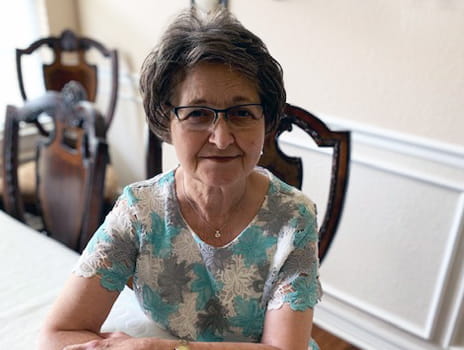August 08, 2022
For more than a decade, Evelyn Bowen dealt with the frustration of her hands shaking so much that she often had to use a spoon to eat instead of a fork. She used straws to drink because the tremors would cause her drinks to spill.
Evelyn was diagnosed with essential tremor, a neurological movement disorder that most often causes the hands to shake uncontrollably. It can also affect the head, voice or legs. It is often mistaken for tremors caused by Parkinson’s disease. While the signs are similar, they have different causes. Essential tremor occurs on both sides of the body and worsens with movement, while tremors caused by Parkinson’s disease tend to start on one side of the body and are more noticeable when the hands are at rest.
Evelyn had seen a couple of neurologists in Arkansas, where she lives, but she still didn’t feel her concerns were being addressed when discussing treatment options. Her primary care doctor told her she needed to find a neurologist who specialized in movement disorders.
Getting the care she needed
While doing her own research to find a neurologist, she found the team of specialists at The University of Kansas Health System. Advocating for her health needs, she was able to transfer her care to Kansas City where she sees our movement disorder care team.
Her tremor continued to get worse over time, and she was having difficulty with daily living activities such as eating, drinking and writing. It also affected her ability to enjoy her hobbies.
“The tremors are kind of embarrassing, and then someone walks up to you and asks why you’re shaking. You explain it to them and they look at you funny, like it doesn’t make sense,” Evelyn says. “It’s been going on for 10-plus years and I was on the highest dose of medication they could give me."
Essential tremor starts slowly and for some people can start when a teenager, although it most commonly develops after age 40. For some, it doesn’t worsen to a point that it impacts their life. However, in others, like Evelyn, the tremors can become so disabling that medication may not help. This is when Exablate Neuro, the commercial name for MRI-guided focused ultrasound, may better meet their needs. The technology can penetrate the skull and treat the brain without making incisions.
A person who needs this type of treatment should see a neurologist who specializes in neurological movement disorders when they begin having trouble with their daily activities such as eating, drinking or getting dressed. Even a small tremor can impact a person’s quality of life or profession. About 50% of people with tremor, like Evelyn, get little or no benefit from medication.
After a careful evaluation by her neurology team at The University of Kansas Health System, Evelyn was identified as a good candidate for the Exablate procedure to improve her hand tremors.
How MRI-guided focused ultrasound works
Neurosurgeon Michael Kinsman, MD, performed Evelyn’s focused ultrasound procedure. “Before the procedure begins, we get a CT scan of the patient’s head,” Dr. Kinsman says. “It lets us see the patient’s skull and how we’ll be able to deliver the ultrasound to the spot in the brain we are targeting.”
The focused ultrasound procedure takes place in an MRI suite where the care team can monitor the location and temperature of the ultrasound beam, using special equipment in the MRI control room. The patient wears a helmet that guides the ultrasound beam only to the location in the brain that causes tremors. The patient is awake throughout the procedure so they can provide feedback.
During the procedure, the team asked Evelyn how she was feeling and if she was experiencing a pressure headache or other discomfort. She also performed tasks such as acting as if she were holding a cup and drinking, writing her name or drawing a spiral so Dr. Kinsman could see the degree of improvement as the procedure continued.
“As we noticed her tremor getting better and she wasn’t having side effects, we verified that we were in the right place and getting good results,” says Dr. Kinsman. “Then we continued into the part of the procedure where we made permanent lesions. But it’s during the verification process when she really noticed the changes.”
Improving quality of life
Two months after her procedure, Evelyn is back in Arkansas and says she is doing great. She was treated for tremors on her right side and they have improved significantly after her procedure.
“Most patients have a really dramatic improvement in their tremor from about 75% or 80% and oftentimes over 90% improvement in their tremor,” says Dr. Kinsman.
“I can now write, hold a fork when eating, use a computer and not be embarrassed to put my hand on a table because it doesn’t shake anymore,” Evelyn says. “I went into surgery with tremors on my right side, came out with no tremors on my right side, and got in the car and came back to Arkansas.”
Evelyn was the 100th person to receive MRI-guided focused ultrasound at the health system. Dr. Kinsman says the movement disorder care team is happy to have been able to help so many people improve their quality of life. It has taken the entire team of movement disorder neurologists, MRI technologists, anesthesiology team and nurses to get to this point. “It’s fantastic to be able to help all these patients,” says Dr. Kinsman.
“If you haven’t had this procedure and have tremors, don’t wait to schedule an appointment with this care team,” Evelyn says. “They will put you on the right track. Follow in my footsteps. You won’t regret it.”





